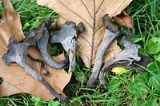
Craterellus
Encyclopedia
Craterellus is a genus of generally edible fungi similar to the closely related chanterelles
, with some species recently reassigned to this genus. They are distinguished by their lack of gill-like structures on the underside of their caps.
Both species are gathered commercially and, unlike Cantharellus
, can be easily preserved by drying.
Molecular phylogenetics have been applied to the problem of discriminating between Craterellus and Cantharellus genera. Results indicate that the presence of a hollow stem may be a synapomorphy
to identify Craterellus species. C. cornucopioides appears to be a single polymorphic
species, while C. tubaeformis may be two separate genetic groups separated by geography.
Cantharellus
Cantharellus is a genus of popular edible mushrooms, commonly known as chanterelles . They are mycorrhizal fungi, meaning they form symbiotic associations with plants, making them very difficult to cultivate...
, with some species recently reassigned to this genus. They are distinguished by their lack of gill-like structures on the underside of their caps.
- C. cornucopioidesCraterellus cornucopioidesCraterellus cornucopioides is an edible mushroom, also known as trumpet of death, black chanterelle, black trumpet, or horn of plenty. The Cornucopia, in Greek mythology, referred to the magnificent horn of the goat Amalthea, that filled itself with whatever meat or drink its owner requested...
, or black trumpet, is dark coloured, almost black and looks rather unattractive, but has a very good flavour. - C. tubaeformis, or yellowfoot, is a yellowish-brown and trumpet-shaped.
- C. lutescens, similar to C. tubaeformis but more brightly coloured.
Both species are gathered commercially and, unlike Cantharellus
Cantharellus
Cantharellus is a genus of popular edible mushrooms, commonly known as chanterelles . They are mycorrhizal fungi, meaning they form symbiotic associations with plants, making them very difficult to cultivate...
, can be easily preserved by drying.
Molecular phylogenetics have been applied to the problem of discriminating between Craterellus and Cantharellus genera. Results indicate that the presence of a hollow stem may be a synapomorphy
Synapomorphy
In cladistics, a synapomorphy or synapomorphic character is a trait that is shared by two or more taxa and their most recent common ancestor, whose ancestor in turn does not possess the trait. A synapomorphy is thus an apomorphy visible in multiple taxa, where the trait in question originates in...
to identify Craterellus species. C. cornucopioides appears to be a single polymorphic
Polymorphism (biology)
Polymorphism in biology occurs when two or more clearly different phenotypes exist in the same population of a species — in other words, the occurrence of more than one form or morph...
species, while C. tubaeformis may be two separate genetic groups separated by geography.
External links
- Craterellus in Index FungorumIndex FungorumIndex Fungorum, an international project to index all formal names in the Fungi Kingdom. Somewhat comparable to the IPNI, but with more contributing institutions....
- Mushroom-collecting.com: Craterellus cornucopioides
- AmericanMushrooms.com: Best Edible Wild Mushrooms
- MykoWeb California Fungi: Craterellus cornucopioides
- MykoWeb California Fungi: Cantharellus tubaeformis
- Taxonomy in Transition: The Cantharellus/Craterellus Clade
- Craterellus cornucopioides Healing-Mushrooms.net, March 2008.

